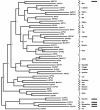Novel snake papillomavirus does not cluster with other non-mammalian papillomaviruses
- PMID: 21910860
- PMCID: PMC3179961
- DOI: 10.1186/1743-422X-8-436
Novel snake papillomavirus does not cluster with other non-mammalian papillomaviruses
Abstract
Papillomaviruses (PVs) are associated with the development of neoplasias and have been found in several different species, most of them in humans and other mammals. We identified, cloned and sequenced PV DNA from pigmented papilloma-like lesions of a diamond python (Morelia spilota spilota). This represents the first complete PV genome discovered in a Squamata host (MsPV1). It consists of 7048 nt and contains the characteristic open reading (ORF) frames E6, E7, E1, E2, L1 and L2. The L1 ORF sequence showed the highest percentage of sequence identities to human PV5 (57.9%) and Caribbean manatee (Trichechus manatus) PV1 (55.4%), thus, establishing a new clade. According to phylogenetic analysis, the MsPV1 genome clusters with PVs of mammalian rather than sauropsid hosts.
Figures


References
-
- Howley PM, Lowy DR. In: Fields Virology. 5. Knipe DM, Howley PM, editor. Vol. 2. Philadelphia: Lippincott Williams and Wikins; 2007. Papillomaviruses; pp. 2299–2354.
-
- Tachezy R, Rector A, Havelkova M, Wollants E, Fiten P, Opdenakker G, Jenson AB, Sundberg JP, Van Ranst M. Avian papillomaviruses: the parrot Psittacus erithacus papillomavirus (PePV) genome has a unique organization of the early protein region and is phylogenetically related to the chaffinch papillomavirus. BMC Microbiol. 2002;2:19–28. doi: 10.1186/1471-2180-2-19. - DOI - PMC - PubMed
MeSH terms
Substances
LinkOut - more resources
Full Text Sources
Research Materials

